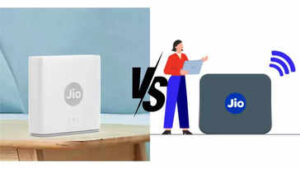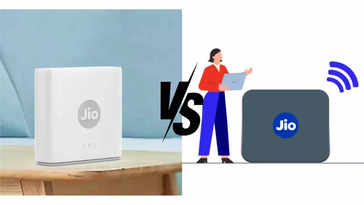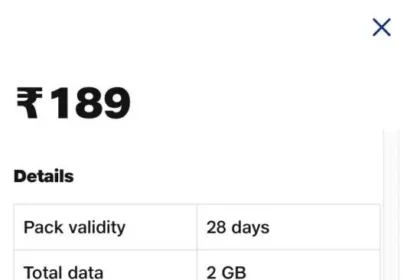Introduction
India’s top telecommunication behemoth, Reliance Jio, now has not one but two robust broadband solutions, JioFiber and Jio AirFiber, to support the nation’s increasing digital requirements. Jio Airfiber and JioFiber are pegged to deliver high-speed internet along with bundled OTT entertainment, but they are based on entirely different technologies. Jio Fiber adopts the conventional fibre-to-the-home (FTTH) wired network, while Jio AirFiber is an innovative 5G-powered wireless broadband service that doesn’t involve any underground cable.
In 2025, reliable and quick home internet is more important than ever. From remote work and online learning to streaming 4K, cloud gaming, and smart home devices, every household requires error-free connectivity. As India’s digital infrastructure continues to change at a breakneck speed, most users are now stuck in a new predicament—not “whether” to acquire internet, but “which one” to opt for from these two Jio plans.
Understanding the Basics
Jio Fiber is the lead wired broadband service of Reliance Jio based on Fiber-to-the-Home (FTTH) technology. It provides internet through optical fibre cables that are directly connected to your home. This provides a very stable and high-speed connection with symmetrical download and upload speeds. Jio Fiber also offers landline calling, smart home integration, and bundled access to OTT services like Netflix, Prime Video, Disney+ Hotstar, and more, based on the plan.

The fundamental difference is the way the internet is delivered. Jio Fiber needs physical infrastructure (fibres, technician visits, splicing, etc.), which takes time to set up and perhaps will not be possible in all areas—especially rural or apartment areas with high population density and wiring issues. Jio AirFiber, on the other hand, is essentially plug-and-play. Provided your area has strong 5G signal strength, you can be connected with minimal configuration—no digging, no wiring.
Speed and Performance Comparison
Both Jio Fiber and Jio AirFiber offer impressive raw performance and speed figures on paper. Still, real-world experience varies greatly based on usage scenarios and environments.
Jio Fiber plans begin from 30 Mbps and reach as high as 1 Gbps, with symmetrical speeds—i.e., upload speed is the same as download speed. This comes in handy, particularly for activities such as uploading big files, YouTube streaming, video calls, or accessing cloud applications. Since it is based on a hardwired fibre-optic connection, latency is normally minimal—often below 10 ms—and thus very suitable for online gaming, real-time video calls, and 4K or 8K streaming.
Jio AirFiber’s plans are as low as 100 Mbps to as high as 1 Gbps, depending on your location and signal quality. However, as it’s a wireless internet based on Jio’s 5G network, the upload speeds tend to be lower than download speeds, and latency is highly variable. Under the best of circumstances, users may see speeds of nearly 1 Gbps with latency of 20–50 ms, which is good enough for most uses. However, under heavy usage times or in areas where 5G is spotty at best, users can see speed fluctuations, increased ping, and systematic buffering on high-bandwidth usage.
One of the most important considerations is speed consistency over time. Jio Fiber generally maintains a stable speed throughout the day because of its dedicated line and lesser impact from network congestion. AirFiber, being a shared 5G spectrum service, is more prone to fluctuations based on the number of users in your area and network load. For instance, one residing in a high-rise with a good outdoor unit location could receive brilliant speeds. At the same time, another in a crowded building with obstructions might experience dips in performance.
If you require extremely consistent speeds for work, gaming, or content creation, Jio Fiber is the more reliable option. But in areas where fibre isn’t offered and you spend most of your time streaming content or browsing, AirFiber can still provide a good broadband experience—just with some conditions based on your environment.
Installation & Setup
The installation of Jio Fiber and Jio AirFiber is silently different, primarily because of the technology they use.
Jio AirFiber is a plug-and-play wireless solution that consists of two pieces: a 5G outdoor unit (which is normally fixed on a window or balcony for maximum signal capture) and an indoor Wi-Fi router that shares internet throughout your home. A technician can still be used to put the outdoor device in place, but there’s no excavation, no cable installation, and minimal hardware. When the device is installed and powered on, activation is usually done within a few minutes to a few hours, depending on signal strength and backend provisioning.
With regard to time to activation, Jio AirFiber is obviously the winner here—it’s usually up and running on the same day. Jio Fiber, although providing more reliable connectivity, can be slower to install, particularly in areas where there’s limited fibre deployment. For tenants or customers who require speedy, low-hassle installation, AirFiber can be a far superior alternative.
Pricing & Plans Breakdown
As for pricing, both Jio Fiber and Jio AirFiber have multiple plans available, but there are some differences in terms of structure, value, and what you receive at each price level.
Jio Fiber begins with a very low-cost Rs. 399/month plan, which comes with 30 Mbps speeds—perfect for regular browsing, video calls, and standard definition streaming. From there, prices go up to Rs. 699, Rs. 999, Rs. 1499, and beyond, with speeds reaching up to 1 Gbps. The Rs. 999 and upwards plans typically come with bundled OTT subscriptions like Netflix (Basic), Amazon Prime Video, Disney+ Hotstar, JioCinema Premium, SonyLIV, Zee5, and more. This makes mid-range to higher-end Jio Fiber plans an attractive one-stop entertainment and internet solution for families or multi-device homes.
Jio AirFiber plans start at Rs. 599/month, with 100 Mbps speed and access to 550+ digital TV channels, as well as OTT apps. AirFiber consists of two plan types—standard and Max. Max plans, at the price of Rs. 1,499, Rs. 2,499, and Rs. 3,999, provide faster speeds (up to 1 Gbps) and include paid OTT services like Netflix, Prime Video, and more, akin to Fiber plans. However, AirFiber plans are slightly more expensive than Fiber at every tier simply because of the wireless 5G network and the added TV+OTT experience.
When it comes to value for money, Jio Fiber continues to be better cost-wise, particularly if you’re looking to utilize only internet speed and OTT. The Rs. 999 Fiber plan, for example, is good value: 150 Mbps speed, unlimited data (with FUP), and a complete OTT bundle. AirFiber, though providing identical benefits, is usually priced a few hundred rupees higher for equivalent features. That being said, AirFiber’s actual value comes in its presence in fiber-scarce areas and the ease of installation it provides, which can be worth the price difference for some.
Availability & Coverage
Jio Fiber and Jio AirFiber both have varying availability footprints in India because of the type of technologies involved.
Jio Fiber is readily available in the majority of major urban cities, metropolitan areas, and tier-1 and tier-2 towns upon which fibre-optic networks have been deployed. It has good coverage in metros such as Mumbai, Delhi, Bengaluru, Hyderabad, Pune, and Ahmedabad. Its rollout to rural and far-flung areas, however, remains limited because deploying fibre cables underground takes time, costs a lot, and is frequently not feasible in small towns or hilly regions.
Jio AirFiber has been introduced to fill the connectivity divide in places where Jio Fiber cannot access. Because it operates on Jio’s current 5G network, its deployment is far quicker and more agile. As of 2025, AirFiber is already present in thousands of towns and semi-urban locations, particularly those with good Jio 5G coverage but no physical fibre connectivity. This makes it an attractive choice for small towns, newly built societies, and rural homes.
For city users, both services are usually available, and the choice then is speed stability vs ease of installation. For rural or semi-urban areas, AirFiber is more commonly available and tends to be the sole Jio broadband choice.
Before making a choice, it’s essential to verify service availability at your exact location. Jio has an official availability checker on its website and MyJio app. Jio Fiber will let you know if the fibre has been installed in your building or complex. For AirFiber, the utility gauges 5G signal coverage.
What’s Best for You?
Selecting between Jio Fiber and Jio AirFiber ultimately comes down to your individual needs, lifestyle, and location. Each user type gains differently depending on what matters most to them.
For streamers and gamers, Jio Fiber is the natural choice. Its low latency, symmetrical upload and download speeds, and stable wired connection make it perfect for online gaming, live streaming, and watching 4K content. AirFiber, though fast on paper, tends to experience inconsistent speeds and higher ping due to its wireless nature—something that is a no-no for hardcore gamers.
If you reside in a rural region or an area where fibre optic cables have not yet been established, Jio AirFiber is the solution. Based on Jio’s growing 5G network, it makes high-speed internet available in regions that otherwise would be limited to slow mobile data or no broadband connectivity whatsoever. Provided there is reasonable 5G signal strength, AirFiber can prove to be revolutionary for rural homes.
Jio Airfiber’s wireless aspect is extremely handy. There is no waiting around for a fibre connection to be installed or removed every time you move residences. You pick up the device and reattach it, and you’re online with little hassle and downtime.
Jio Fiber – Advantages & Disadvantages
- Extremely stable speeds with consistent upload and download
- Low latency, perfect for gaming, streaming, and remote working
- Inexpensive entry-level plans at Rs. 399/month
- Broader OTT bundle offer at lower plan levels
- Sustained performance even during peak hours
- Longer installation duration because of cable laying and technician setup
- Limited coverage in rural and far-flung areas
- Not portable — bound to one physical location
Jio AirFiber – Advantages & Disadvantages
- Easy and fast installation — plug-and-play connection
- Tractable in most places where fibre is not yet installed
- Suitable for renters or frequent movers
- Includes OTT and TV bundles in the majority of plans
- Backed by Jio’s 5G network — no reliance on fibre infrastructure
- Speed may vary depending on 5G signal strength and traffic
- Higher latency than wired connections
- Somewhat pricier than comparable OTT and speed packages
- Speed is dependent on device location and open line-of-sight
Conclusion
Jio Fiber and Jio AirFiber cater to different requirements—and selecting the right one is highly dependent on your location, usage pattern, and connectivity priorities.
If you prioritize speed stability, low latency, and consistent performance, particularly for gaming, remote work, or heavy streaming, and Jio Fiber is available in your location, it’s obviously the best option. Cheap plans, symmetrical speeds, and comprehensive OTT bundles provide fantastic value for money.
On the other hand, if you’re in a place where fibre cables have yet to reach—such as a rural setting, a recently constructed apartment, or even a rented flat where installation is inconvenient—Jio AirFiber is a viable alternative. It’s easy to install, provides reasonable speeds, and is fueled by Jio’s extensive 5G network.
FAQs
- What is the principal difference between Jio Fiber and Jio AirFiber?
Jio Fiber is a wired broadband connection via optical fibre cables, whereas Jio AirFiber is a wireless broadband offering that transmits the internet over Jio’s 5G network.
- Which is faster: Jio Fiber or AirFiber?
Both can provide up to 1 Gbps speeds, but Jio Fiber is generally faster and has lower latency because it’s a wired connection.
- Can I use Jio AirFiber if Jio Fiber is already available in my location?
Yes, you may opt for either service, but it’s advisable to go with Jio Fiber if it is already available.
- Which one would be better for video calling and online gaming?
Jio Fiber is best for gaming and video conferencing because it offers a stable, low-latency connection.
- Is Jio AirFiber really wireless?
Yes, it is a wireless fixed solution with a 5G outdoor unit and an indoor Wi-Fi router—no cables are needed within your house.
- Do both services come with an OTT subscription?
Yes, depending on the plan you opt for, both have bundled OTT apps such as Netflix, Prime Video, Disney+ Hotstar, and JioCinema.








